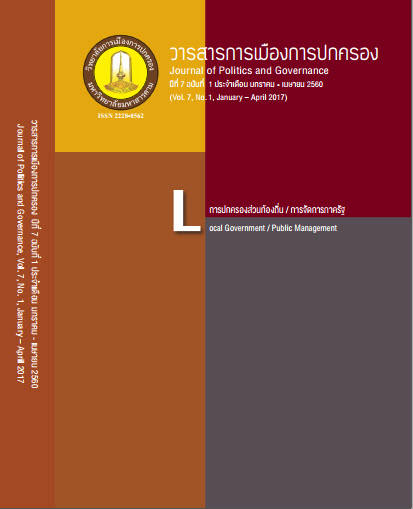Competency Development Division of Teacher Leadership
Main Article Content
Abstract
The objectives of this research and development were 1) to study components of leadership competency development of teachers, 2) to investigate characters and behaviors of teachers’ leadership competency, 3) to create a manual of their leadership competency development and 4) to try out the manual focusing on learners’ learning achievement. Research procedures were divided into 3 phases: In Phase 1, components of teacher development at schools were studied from two sources including 1) research documents and 2) 100 sample teachers who passed the evaluation criteria required by the Teachers’ Council of Thailand. They were purposively selected. The research tool was a five-rating questionnaire with the reliability of 0.74. The statistics employed in this research were percentage, mean and standard deviation. In Phase 2, the manual for developing teachers’ leadership competency was created. Its correctness was affirmed by seven experts via structured interview, and its possibility and appropriateness was also approved by the experts. In Phrase 3, the manual was tried out by using it with 30 teachers whose teaching performance was satisfactory. The pre- and post evaluations were also made. 1. The components of teacher development consisted of five aspects : 1) armature appropriate for being teachers, 2) creative conversation, 3) personnel of changes, 4) considerable performance and 5) development for learners’ accomplishment. 2. Regarding their characters and behaviors, it was found that the majority of the samples were females (65 %) holding a professional level (73 %), B.A. degree (81 %), and having more than 10 years of teaching experiences (83%). 121-300 teachers worked at medium schools (84 %). They were ready for external assurance of leadership competency development at a high level ( = 4.18). Upon considering each aspect, it showed that two aspects i.e. considerable performance (
= 4.67) and armature appropriate for being teachers (
= 4.53) were at the highest level. However, development for learners’ accomplishment (
= 3.47) was at a moderate level. 3. The manual consisted of the following components: objectives, period of developing the table based on the teacher development curriculum, methods of development media and innovation, manual evaluation and its appropriateness and possibility approved by the experts. 4. Three steps of developing teachers: Step 1, pre-procedure, Step 2, procedure and workshop using the developed manual and Step 3, post-workshop including meetings and a questionnaire about teachers’ behaviors. Moreover, the evaluation of teachers at the schools for leadership competency after their participation in the workshop was higher than before the attending the workshop.
Article Details
References
กษมา วรวรรณ ณ อยุทธยา. (2550). การประกันคุณภาพการศึกษา. การปฏิรูปการศึกษา.
จินตนา ศรีสารคาม. (2554). การวิจัยและพัฒนาโปรแกรมพัฒนาภาวะผู้นำทางวิชาการในสถานศึกษาขั้นพื้นฐาน.วิทยานิพนธ์ปรัชญาดุษฎีบัณฑิต (การบริหารการศึกษา). ขอนแก่น :
บัณฑิตวิทยาลัยมหาวิทยาลัยขอนแก่น.
สมใจ อุดมศรี. (2554). การพัฒนาตัวบ่งชี้การกระจายอำนาจการบริหารงานวิชาการในสถานศึกษาขั้นพื้นฐาน. วิทยานิพนธ์ปรัชญาดุษฎีบัณฑิต (การบริหารการศึกษา). ขอนแก่น : บัณฑิต
วิทยาลัย มหาวิทยาลัยขอนแก่น.
ศุภกานต์ ประเสริฐรัตนะ. (2555) . โมเดลสมการโครงสร้างภาวะผู้นำแบบการกระจายอำนาจของโมเดลสมการโครงสร้างภาวะผู้นำแบบการกระจายอำนาจของผู้บริหารสถานศึกษาขั้นพื้นฐาน.
วิทยานิพนธ์ปรัชญาดุษฎีบัณฑิต (การบริหารการศึกษา). ขอนแก่น : บัณฑิตวิทยาลัย
เพชริน สงค์ประเสริฐ. (2550). การพัฒนารูปแบบการบริหารงานวิชาการโดยยึดหลักการทำงานเป็นทีมในสถานศึกษาขั้นพื้นฐาน. วิทยานิพนธ์ปรัชญาดุษฎีบัณฑิต (การบริหารการศึกษา).
พิษณุโลก : บัณฑิตวิทยาลัย มหาวิทยาลัยนเรศวร.
บุญชม ศรีสะอาด. (2554 ). การวิจัยเบื้องต้น. พิมพ์ครั้งที่ 8 กรุงเทพฯ : สุวีริยาสาสน์.
มนชัย พินิจจิตรสมุทร. (2548). Dialogue เพื่อการสร้างองค์กรแห่งการเรียนรู้ For Quality .11(89).
รังสรรค์ ประเสริฐศรี. (2544). ภาวะผู้นำ .กรุงเทพฯ.ธรธัชการพิมพ์ : มหาวิทยาลัยศิลปากร.
นงลักษณ์ เรือนทอง. (2550). รูปแบบการบริหารโรงเรียนที่มีประสิทธิภาพ. วิทยานิพนธ์ปรัชญาดุษฎีบัณฑิต (การบริหารการศึกษา).
นครปฐม : บัณฑิตวิทยาลัย มหาวิทยาลัยศิลปากร.
วิโรจน์ สารัตนะ. (2548). ผู้บริหารโรงเรียน :สามมิติการพัฒนาวิชาชีพสู่ความเป็นผู้บริหารที่มีประสิทธิผล. ขอนแก่น: คลังนานาวิทยา.
ศศิกานต์ เจริญดี. (2544). การศึกษาการทำงานเป็นทีมของผู้บริหารโรงเรียนประถมศึกษา.วิทยานิพนธ์ ปร.ด. (การบริหารการศึกษา).
ขอนแก่น : บัณฑิตวิทยาลัย มหาวิทยาลัยนเรศวร.
สุเทพ พงศ์ศรีวัฒน์. (2548). ภาวะผู้นำ :ทฤษฎีการปฏิบัติ :ศาสตร์และศิลป์สู่ความเป็นผู้นำที่สมบูรณ์. กรุงเทพฯ : วิรัตน์เอ็ดดูเคชั่น.
สมคิด อิสระวัฒน์. (2543). การสอนผู้ใหญ่. กรุงเทพมหานคร.จรัญสนิทวงศ์การพิมพ์.
สุวัฒน์ วัฒนวงศ์. (2547). จิตวิทยาเพื่อการฝึกอบรมผู้ใหญ่. กรุงเทพมหานคร.ด่านสุธาการพิมพ์.
เสกสรร มธุลาภรังสรรค์สุคนธ์ สินธพานนท์ วรรัตน์ วรรณเลิศลักษณ์ และพรรณี สินธพานนท์ โสฬส ศิริไส. (2551). พัฒนาทักษะ
การคิดตามแนวปฏิรูปการศึกษา. กรุงเทพฯ : หจก. 9119 เทคนิคพริ้นติ้ง.
สำนักงานเลขาธิการสภาการศึกษา. (2551). นโยบายยกระดับคุณภาพครูทั้งระบบครูทั้งระบบ.กรุงเทพฯ: คุรุสภาลาดพร้าว.
สำนักงานคณะกรรมการการศึกษาขั้นพื้นฐาน. (2553). คู่มือประเมินสมรรถนะครู (ฉบับปรับปรุง).สำนักงานพัฒนาครูและบุคลากร
ทางการศึกษา.สำนักงานคณะกรรมการการศึกษา ขั้นพื้นฐาน.
สำนักงานเลขาธิการสภาการศึกษา. (2551). รายงานการวิจัย สมรรถนะครูและแนวทางการพัฒนาครูในสังคมที่เปลี่ยนแปลง.
กรุงเทพฯ: สกค.
อุษาวดี จันทรสนธิ. (2550). ภาวะผู้นำของครูในสถานศึกษา. วารสารศึกษาศาสตร์ มสธ.ปีที่ 1 (2), ธันวาคม – พฤษภาคม 2550.
มหาวิทยาลัยสุโขทัยธรรมาธิราช.
Acker- Hocevar and Touchton. (1999). A model of power as social relationships : Teacher leaders describe the phenomena of effective agency in practice. Paper presented
at the annual meeting of the American Educational Research Association, Montreal, Quebec, Canada.
Boles, K. & Troen, V. (1992). How teachers make restructuring happen. Educational Leadership, 49 (5), 53-56.
Childs-Bowen and Scrivner . (2000). Principals: Leaders of Leaders. NASSP Bulletin, 84(616), 27-34.
Fullan. (1994 ). Change Forces: Probing the Depths of Educational Reform. London : Falmer Press: 16-20.
Katzenmeyer and Moller. (2001). Awakening the Sleeping Giant: Helping Teacher Develop as Leaders. 2nd ed.
Thousand Oaks, CA: Corwin.
Leithwood and Duke. (1999). A century’s quest to understand school leadership. In K.S. :73
Pellicer and Anderson.(1995). A handbook for teacher leaders. Thousand Oaks, CA : Corwin Press.: 9-11.
Sherrill, J. (1999). Preparing teachers for leadership roles in the 21st century. Theory intoPractice,38(1), 56–61.
Snell and Swanson .(2000). The Essential Knowledge and Skills of Teacher Leaders: A Search for a Conceptual
Framework. Paper presented at the Annual Meeting of the American Education Research Association, New
Orleans, L.A.:77


